Google’s Continuous Scroll and what it means to SEO Google’s Continuous Scroll and what it means to SEO
In December of last year, Google introduced continuous scroll to its desktop search results which has found its way into most desktop searches universally. Instead of the traditional See More button at the end of each page, Google results will now keep appearing as the user scrolls, loading up to six pages before the See More button appears. This shift raised alarms among those committed to SEO practices, as long-held beliefs and techniques could be suddenly upended.
Traditionally, search results have been returned on a page-by-page basis, with the first page being the most valued of all, but this newly introduced change has done away with the page-one concept.
From Static Page to Scrolling
Google’s move to a scrolling search results page reflects an overall trend on how internet pages in general are now being displayed.
Most webpages now extend well below the fold (the first screen of content) and content is mostly reachable through scrolling, which has become the easiest way to navigate a website. Content is loaded on-demand – the user will trigger more content as they scroll, a function that most social media platforms have already embraced.
SEO practices still heavily rely on the page-by-page concept to assign keywords to certain pieces of content, and it is this practice that will likely be affected by the change, not so much by outcomes, but more so by terminology.
Page One and Its Benefits
The first page of returned search results has long been the coveted position for businesses and SEO practitioners alike, with the top three positions alone securing approximately 54% of user clickthroughs, and pages two and onwards only securing approximately 2% to 9% of clicks. With the structured hierarchy of the page system now being replaced with a scrolling experience there will be most likely a change to the way that users consume and initiate their actions, but to what extent is still to be seen.
SEO practitioners will likely no longer refer to “page one” in their communications and instead, refer to the top ten organic listings (or top 20, and so on).
How Will Continuous Scroll Impact Search and SEO?
These newly implemented changes to the appearance of Google’s search results will most likely bring new behaviours in the way that users interact with their results. But behavioural trends tell us that regardless of the function, Google users will want answers fast regardless – be it by way of pages or scrolling. In that sense, “scroll three” may well become the new page two.
No More Page One
This change is obvious and is already witnessed in desktop searches. With Google implementing continuous scroll to its search results, page one is no more, in theory at least. The new page one is now essentially six pages, of which pages two through five appear as the user scrolls (on mobile this is reduced to four pages).
More Results Will Likely Be Viewed (For Now…)
With the “page” barrier removed, it is likely that users will now view more results by scrolling further down than what they may have previously done. However, as was the case with the traditional page structure, it will likely only be a matter of time that three or four scrolls will become the new page two or three. Regardless of the structure, users want answers fast.
The Top Three Search Positions May Loosen Their Hold
Currently, the top three returned results are where most organic clicks go, and this is unlikely to change, though the overall dominance of these positions may be reduced temporarily. This would reflect a broader change in search use, whereas once the top result would garner approximately 40% of clicks, nowadays that number is closer to 28%.
More Advertisements are Probably On Their Way…
Google is a business first and foremost, and with more potential space in search results becoming available, it is likely that users will now be exposed to more advertisements and suggested features than they have before.
The majority of this will likely continue to be seen at the top of the returned results, with other placement areas such as at the beginning of each “fold” likely to be utilised.
Can Businesses Still Control Their Rankings?
How can creators, publishers and SEO practitioners adapt to these new changes and still secure a high position in the search results? Well, to this point, the search algorithm has not changed – SEO results will still be achieved as they have been previously since the last algorithm update. But we will instead need to talk about position rather than pages.
Regardless of the new changes, the top ten of a returned search is still where businesses will want to be. The search result structure will not change this. And given that there are likely to be more results that searchers will choose from, at least in the short term, making sure your SEO structure is on-point is paramount.









